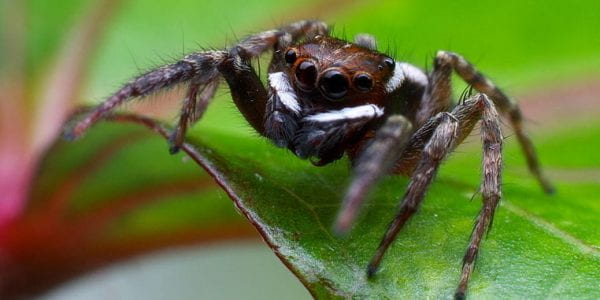If it were not for YouTube and Instagram, I never would have known that spiders are being kept as pets all around the world. From the tarantulas and huntsman spiders to orb weavers and jumpers. They apparently make great pets because of their relatively low maintenance, compared to the typical cats, dogs, fish, birds, hamsters etc., and they have different personalities. “WHAT? PERSONALITIES?!” some might think. Yes, yes they do.
Spiders usually hate having their abdomen (their butts) touched as it contains most of their vital organs and will run away, but this one is so chill with it!
Keeping spiders as pets help to educate people about them and removes bits of the stigmatism toward them, creating a larger community of those who are less/not afraid of these arachnids. Apparently, even movies like Spider-man can help to cure arachnophobia too[1]!
Sadly, having spiders as pets can create problems that go unseen. Spiders are technically exotic pets[2] and with it comes the exotic pet trade. As some of us are aware, exotic trade has a notoriously bad reputation because of the nature of animals traded and the source of these animals.
The animals traded here are usually not domesticated and therefore, have zero experience with living in our human homes and their cages. They are simply not meant to live that lifestyle. Having such a drastic change in the living conditions would stress the animal and cause them to behave differently. Should the animal refuse to eat or drink, it would die. If it continues to live but behave in an unfavourable way toward the owner, it might be released from its prison and into a new environment, one far from its native homeland. Thus, introducing a potentially invasive species. A classic example of this is the Burmese python’s introduction into the United States[3] which is thought of as the cause for decreasing population of other prey species[4]. Fellow course-mate Goh Li Xuan did a blog post about this exact snake in her blog which I recommend you read (after finishing my post).
- They are not burmese pythons but ball pythons from another famous exotic pet café in Bangkok
- I understand that the trade isn’t good for them but they’re so adorable
Aside from being an invasive species, we humans also do not have much exposure to these animals, exposing us and other organisms to new pathogens[5]. This has the potential to create another Covid19 problem that I am certain many of us want to avoid.
References:
1. Hoffman YSG, Pitcho-Prelorentzos S, Ring L, Ben-Ezra M. “Spidey Can”: Preliminary Evidence Showing Arachnophobia Symptom Reduction Due to Superhero Movie Exposure. Frontiers in psychiatry. 2019;10:354
2. https://www.nationalgeographic.com/animals/reference/exotic-pet-trade/
3. https://www.nature.org/en-us/about-us/where-we-work/united-states/florida/stories-in-florida/stopping-a-burmese-python-invasion/
4. Dorcas ME, Willson JD, Reed RN, Snow RW, Rochford MR, Miller MA, et al. Severe mammal declines coincide with proliferation of invasive Burmese pythons in Everglades National Park. Proceedings of the National Academy of Sciences – PNAS. 2012;109(7):2418-22
5. van Roon A, Maas M, Toale D, Tafro N, van der Giessen J. Live exotic animals legally and illegally imported via the main Dutch airport and considerations for public health. PloS one. 2019;14(7):e0220122-





Hi Justin,
I see how normalising spiders as pets can reduce our misconceptions and biases against them. Perhaps instead of importing exotic spiders, we can encourage safe ways to interact with common spiders in our homes. I’ve noticed how you often bring up that these spiders prey on mosquitoes in the comments – that may help to improve our perception of them. Otherwise, are there local species of spiders that are suited for the pet trade?
Personally, I was quite disappointed that the top three results when I searched for “common spiders Singapore” were all from pest control sites. We do seem to have this thing where we treat all conflicts with animals as a pest control issue, from spiders to house geckos and snakes.
Hi Ee Kin!
Sadly, almost anything that enters one’s house that isn’t a human seems to be deemed as a pest. Education and interaction will surely change that!
I often bring up the Hasarius Adansoni as it is a very common jumping spider that can be found in houses. I think the cosmopolitan jumping spiders such as the Hasarius Adansoni and Menemerus Bivittatus are fairly well suited for the pet trade as they are already adapted to our urban areas, are easy to feed (they feed on mosquitos, flies and ants), and easy to keep since they are so small and tend to build a small “house” to sleep in. Practicalities aside, being jumpers, they are naturally curious, allowing people to interact with them.
The most common spiders seen in the pet trade are however, tarantulas, which are the largest spiders in the world by body length and mass. I think they are popular because they live in burrows and almost never leave them, and they love to be left alone. Some species are gentle giants while others are notoriously aggressive. Most species are ground-dwelling and a fall from height of 15cm can be enough to kill them. I don’t think they are as well suited for the pet trade for these reasons.
Hi Justin,
Great reply to Ee Kin’s excellent Q. Just one detail. When using scientific names, only capitalise the genus (not the species) epithet. So (if I could use italics, which I can’t in comments, Hasarius adansoni
jc
Ah I see. Thanks for correcting me Dr Coleman!
Hi Justin,
I have two Qs.
1) Are there examples of zoonotic disease transmission to humans from wild reservoirs other than mammals or birds ? I’m not aware of any pathogens harboured by arthropods that have caused diseases in humans (not talking about vectors, mind you).
2) The exotic pet trade has much larger implications than those on the individual animals involved and even the potential introduction of non-native species that could be come invasive (ps, check out the story of the monk parakeet in the US if you’re interested). What issue do you think I might be referring to, primarily ? And, are there examples of it affecting spiders ? If you’re not sure what I’m talking about, wait until week 8 – it may become clearer.
Thanks,
jc
Hi Dr Coleman,
I was actually thinking of ticks and mites that might latch on to the larger spiders but now that you pointed it out, they are indeed vectors. However, don’t they still pose a threat?
It seems the issue of the exotic pet trade is an extremely complicated one that depends on how the animals adapt to their new natural human environment? Looks like crop consumption and growing population in new land against the declining populations in the native land are the main points…? I’ll look into the effect on spiders directly and share it in a blog post itself if it is substantial enough.
Thanks Dr Coleman
Hi Justin,
Well, you mentioned “new pathogens” in your post. And while it’s true that ticks & mites can be vectors for diseases of major public health importance, the diseases normally emerge from other reservoir species, and to my knowledge, they’re all birds & mammals (but I could be wrong). Usually, but not always, vector-borne diseases are transmitted by native arthropods. Like, when I think about sleeping sickness, malaria, chagas disease, west nile virus, etc…. the insect vectors are native.
I look forward to seeing what other environmental issue you might discover about the exotic pet trade. I encourage you to speak with Prof LI Daiqin or Prof Antonia Monteiro to learn more, especially insofar as the trade in arthropods is concerned.
jc